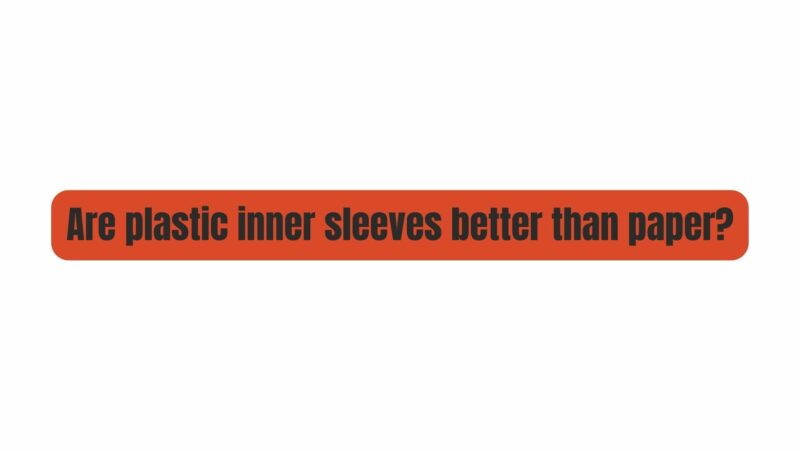The resurgence of vinyl records in recent years has ignited passionate discussions among audiophiles and collectors about the best practices for preserving and protecting their cherished vinyl collections. At the heart of this debate lies the question: Are plastic inner sleeves better than paper? Both options have their merits, and this article aims to delve deep into the topic, exploring the advantages and disadvantages of each to help you make an informed choice for your vinyl treasures.
Section 1: The Role of Inner Sleeves
Before we embark on our comparison, it’s crucial to understand the pivotal role inner sleeves play in safeguarding your vinyl records.
1.1. Dust and Debris Protection
Inner sleeves act as the first line of defense against dust, debris, and potentially harmful particles that can mar the surface of your records and degrade audio quality over time.
1.2. Preventing Scratches and Scuffs
These sleeves serve as a protective barrier, preventing the vinyl surface from coming into direct contact with the inner lining of the outer jacket, thus minimizing the risk of scratches and scuffs.
1.3. Static Electricity Control
Inner sleeves can also help mitigate the buildup of static electricity, which can attract dust and adversely affect playback quality.
Section 2: The Pros and Cons of Plastic Inner Sleeves
Plastic inner sleeves have gained popularity among vinyl enthusiasts, boasting various advantages that make them a compelling choice. Let’s explore the pros and cons in detail.
2.1. Advantages of Plastic Inner Sleeves
2.1.1. Anti-Static Properties: One of the most significant advantages of plastic inner sleeves is their inherent anti-static nature. This feature helps prevent static buildup on your vinyl, reducing the risk of pops and crackles during playback.
2.1.2. Durability: Plastic sleeves, typically made from polyethylene or polypropylene, are remarkably durable. They withstand wear and tear exceptionally well and are less prone to tearing or developing creases compared to paper.
2.1.3. Clarity and Visibility: Clear plastic inner sleeves allow for easy visibility of the record label and cover art, making it convenient to identify records in your collection quickly.
2.2. Drawbacks of Plastic Inner Sleeves
2.2.1. Lack of Breathability: Plastic sleeves are non-breathable, which means they do not allow for the exchange of air inside the sleeve. This can potentially lead to condensation buildup in high-humidity environments.
2.2.2. Choice of Materials: Not all plastic inner sleeves are created equal. Some are made from PVC (polyvinyl chloride), which can release harmful chemicals and damage vinyl records over time. Opting for polyethylene or polypropylene plastic is generally considered safer for your records.
Section 3: The Pros and Cons of Paper Inner Sleeves
Paper inner sleeves, a traditional choice for vinyl collectors, also offer unique advantages and drawbacks. Let’s explore these aspects in detail.
3.1. Advantages of Paper Inner Sleeves
3.1.1. Breathability: Paper sleeves are breathable, allowing for the exchange of air within the sleeve. This feature can be advantageous in preventing the accumulation of moisture and condensation in humid environments.
3.1.2. Acid-Free Options: Many paper inner sleeves are acid-free, meaning they won’t contribute to the degradation of your vinyl records over time. This is especially important for collectors of valuable and rare records.
3.1.3. Vintage Aesthetic: For collectors who appreciate a vintage aesthetic and a touch of nostalgia, paper inner sleeves provide a classic look and feel to their record collection.
3.2. Drawbacks of Paper Inner Sleeves
3.2.1. Limited Anti-Static Properties: Paper sleeves are not inherently anti-static, which means they may not effectively reduce static buildup on vinyl records. This can result in more frequent cleaning and maintenance.
3.2.2. Potential Dust Attraction: Some paper sleeves can attract dust due to their composition, potentially negating their protective qualities. This can be problematic for those who live in dusty environments.
3.2.3. Fragility: Paper sleeves are more delicate and susceptible to wear and tear compared to their plastic counterparts. Over time, they may develop creases and tears, potentially causing damage to your records.
Section 4: Considerations for Your Collection
When choosing between plastic and paper inner sleeves, several critical factors should guide your decision-making process:
4.1. Climate and Storage Environment: Consider the climate of your storage environment. If you reside in a humid area, plastic sleeves may be more suitable due to their anti-static properties and resistance to moisture. In drier climates, paper sleeves may work well.
4.2. Record Value: For collectors with valuable and rare vinyl records, investing in high-quality, acid-free paper sleeves or polyethylene plastic sleeves may be a prudent choice to ensure long-term preservation.
4.3. Personal Preference: Your personal preferences, including your aesthetic preferences and priorities for ease of use, play a significant role in the decision. Some collectors prefer the vintage feel of paper sleeves, while others prioritize practical benefits.
4.4. Budget: Plastic sleeves generally come at a slightly higher cost than paper sleeves. Your budget may influence your choice, but remember that the investment is in the protection of your beloved vinyl collection.
Section 5: Conclusion
In the enduring debate of plastic vs. paper inner sleeves for vinyl records, there is no definitive winner. The ideal choice largely depends on your specific needs, environmental conditions, and personal preferences.
Plastic inner sleeves offer remarkable durability and anti-static properties, making them an excellent choice for many collectors. However, they may not be suitable for extremely humid environments.
On the other hand, paper inner sleeves provide breathability and are acid-free, making them a reliable choice for long-term storage, especially for valuable records. They also appeal to those who appreciate a vintage aesthetic.
Ultimately, the most important factor is ensuring that your chosen inner sleeves effectively protect your cherished vinyl records, preserving the music they hold for years to come. Whether you lean towards plastic or paper, your decision should align with the unique characteristics and storage conditions of your vinyl collection.

